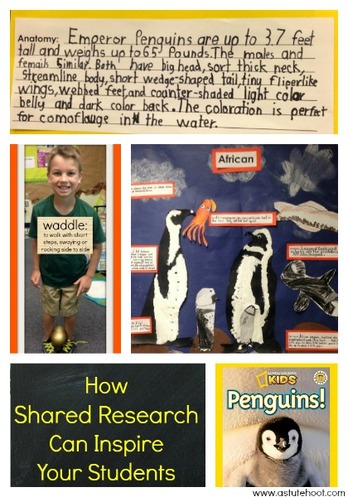
Presenting informational text within a unit of study, helps students explore topics in depth as well as strengthens understanding. I found that students enjoyed become “experts” on topics and were much more motivated to conduct research as a group vs individually.
My second grade students loved our penguin shared research project! It was created to complement the HMH Journeys basal text, Penguin Chick by Betty Tatham. I was amazed to see how interested and engaged my students were throughout the entire unit. I used the following 6 tried-and-true tips to make this a successful shared research study:
- Find engaging, yet challenging resources: I provided a variety of penguin informational text sources including books, printouts, poems, and magazine articles. The sources provided were at a variety of levels–most were at students’ instructional level, but I also included more challenging text to increase stamina and push students to read complex text. I’ve found that when students read high-interest text, they are motivated to tackle difficult text, even if it is slightly above their level. This National Geographic Kids: Penguins book by Anne Schreiber and Penguins! by Gail Gibbons are a few of the high-quality, authentic text sources we used during the study.
- Create shared research groups: Shared research is an ideal time for heterogeneous grouping because students are combining their background knowledge and skill sets and learning from each other to build a shared understanding of the material. I organized students into groups of 4-5 and allowed them to choose their specific research topic (i.e., diet, anatomy, etc.). I wrote students’ research roles on the board and gave them each a research role headband for easy organization. In order to promote productive collaboration, we created a list of behavioral expectations so that everyone knew the expected requirements of shared research.
- Activate background knowledge: I used Really Good Stuff’s O.W.L. (Observe, Wonder, Link) graphic organizer to activate students’ background knowledge. In groups, students brainstormed what they’ve observed about penguins, using knowledge gained from reading the basal text, Penguin Chick. They recorded this information on the O (Observe) column of the O.W.L. graphic organizer. Next, we discussed the importance of asking questions prior to reading to guide research. Students then wrote questions on Post-It notes and sorted them into the following categories: anatomy, diet, habitat, locomotion, life cycle, and predators. After sorting, they stuck their Post-Its onto the W (Wonder) column of the O.W.L graphic organizer.
- Read, write, discuss: Reading, writing, and discussion are the heart of shared research projects. Students should read to find answers, share these answers in a written format, and discuss new learning. In our penguin study, students read to find answers to their questions, summarized their answers and cited textual evidence on the L (Link) column of the O.W.L graphic organizer. Students worked collaboratively to turn their new learning into complete paragraphs about each research sub-topic. They wrote them on lined paper, edited and then published using Sharpie markers.
- Incorporate art: Shared research is the perfect opportunity to incorporate art into the classroom. Written responses don’t have to be limited to reports, they can include murals, posters, poems, or dioramas. My students chose to make murals of their assigned penguin. They used photographs to draw the penguins’ anatomy, diet, habitat, predators, and babies and then used chalk and paint to bring the penguins to life. As a finishing touch, students placed their published paragraphs on the murals.
- Share success: As a culmination, invite parents or other classes to come listen to students share their research projects. My class loved sharing and listening to each penguin report as they truly were penguin experts. Many asked questions and provided feedback. Some even took notes! After students shared, we discussed and charted the similarities and differences of the penguins on a Venn diagram, synthesizing our learning. I was impressed with the depth of knowledge each group gained from this project. They were highly engaged and learned excellent research skills. Many said this was their favorite project (even topping our themed cooking projects--that says a lot!).
Jessica Murphy and Jennifer Zoglman are founders of Astute Hoot: Tools for the Wise Teacher. With a combined total of almost 30 years experience in early childhood and special education classroom teaching, early literacy research, and teacher coaching, they joined forces with Jennifer’s sister, Tina, an award-winning graphic designer, to create a dynamic cast of reading and math strategy animals. The strategy animals made their way into a group of targeted teaching and learning tools that have contributed to the creation of proficient readers and mathematicians in classrooms across the country! Check out their blog: www.astutehoot.com to see how they awaken the joy of learning in all students! If you are interested in purchasing some products that help students learn critical reading and math strategies, consider downloading See What The Hoot’s About, a FREE sample file of tools and resources guaranteed to spark enthusiasm in your classroom.


 RSS Feed
RSS Feed